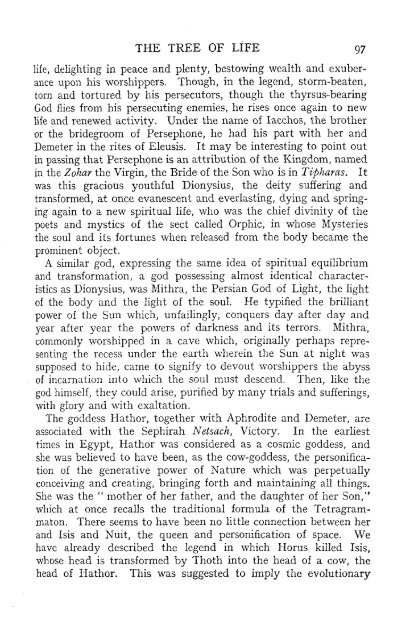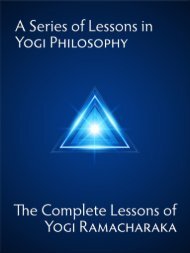3y8u4hFD4
3y8u4hFD4
3y8u4hFD4
Create successful ePaper yourself
Turn your PDF publications into a flip-book with our unique Google optimized e-Paper software.
THE TREE OF LIFE 97<br />
life, delighting in peace and plenty, bestowing wealth and exuberance<br />
upon his worshippers. Though, in the legend, storm-beaten,<br />
torn and tortured by his persecutors, though the thyrsus-bearing<br />
God flies from his persecuting enemies, he rises once again to new<br />
life and renewed activity. Under the name of Iacchos, the brother<br />
or the bridegroom of Persephone, he had his part with her and<br />
Demeter in the rites of Eleusis. It may be interesting to point out<br />
in passing that Persephone is an attribution of the Kingdom, named<br />
in the Zolzar the Virgin, the Bride of the Son who is in Tiplzaras. It<br />
was this gracious youthful Dionysius, the deity suffering and<br />
transformed, at once evanescent and everlasting, dying and springing<br />
again to a new spiritual life, who was the chief divinity of the<br />
poets and mystics of the sect called Orphic, in whose Mysteries<br />
the soul and its fortunes when released from the body became the<br />
prominent object.<br />
A similar god, expressing the same idea of spiritual equilibrium<br />
and transformation, a god possessing almost identical characteristics<br />
as Dionysius, was Mithra, the Persian God of Light, the light<br />
of the body and the light of the soul. He typified the brilliant<br />
power of the Sun which, unfailingly, conquers day after day and<br />
year after year the powers of darkness and its terrors. Mithra,<br />
commonly worshipped in a cave which, originally perhaps representing<br />
the recess under the earth wherein the Sun at night was<br />
supposed to hide, came to signify to devout worsllippers the abyss<br />
of incarnation into which the soul must descend. Then, like the<br />
god himself, they could arise, purified by many trials and sufferings,<br />
with glory and with exaltation.<br />
The goddess Hathor, together with Aphrodite and Demeter, are<br />
associated with the Sephirah Netsach, Victory. In the earliest<br />
times in Egypt, Hathor was considered as a cosmic goddess, and<br />
she was believed to have been, as the cow-goddess, the personification<br />
of the generative power of Nature which was perpetually<br />
conceiving and creating, bringing forth and maintaining all things.<br />
She was the " mother of her father, and the daughter of her Son,"<br />
which at once recalls the traditional formula of the Tetragrammaton.<br />
There seems to have been no little connection between her<br />
and Isis and Nuit, the queen and personification of space. We<br />
have already described the legend in which Horus killed Isis,<br />
whose head is transformed by Thoth into the head of a cow, the<br />
head of Hathor. This was suggested to imply the evolutionary

















